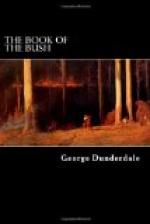It was a tale of western love, and its course was no smoother in Illinois than in any less enlightened country of old Europe. Miss Priscilla reckoned she could hoe her own row. She and Mr. Sellars conducted the Common School at Dresden with great success and harmony. All went merry as a marriage bell, and the marriage was to come off by-and-by—so hoped Miss Priscilla. During the recess she took the teacher’s arm, and they walked to and fro lovingly. All Dresden said it was to be a match, but at the end of the term Miss Priscilla returned to Joliet—the match was not yet made.
It was at this time that the dissatisfaction with the new British teacher became extreme; Miss Priscilla fanned the flame of discontent. She did not “let concealment like a worm i’ th’ bud feed on her damask cheek,” but boldly proposed that Mr. Sellars—a true-born native of New England, a good young man, always seen at meetings on the Sabbath—should be requested to take charge of the West Joliet school. So the meeting was held: I was voted out, Mr. Sellars was voted in, and the daughters of the Puritans triumphed.
Miss Priscilla wrote to Dresden, announcing to her beloved the success of her diplomacy, requesting him to come to Joliet without delay, and assume direction of the new school. This letter fell into the hands of another lady who had just arrived at Dresden from New England in search of her husband, who happened to be Mr. Sellars. The letter which that other lady wrote to Miss Priscilla I did not see, but it was said to be a masterpiece of composition, and it emptied two schools. Mr. Tucker went over to Dresden and looked around for Mr. Sellars, but that gentleman had gone out west, and was never heard of again. The west was a very wide unfenced space, without railways.
“The fact is,” said Mr. Curtis, “we were all kinder shamed the way things turned out, and we just let ’em rip. But people are now stirring about the school being closed so long, so Mr. Strong and Mr. Demmond have concluded to engage you and me to conduct the school.”
We were engaged that night, and I went rail-splitting no more. But I fenced my estate; and while running the line on the western boundary I found the grave of Highland Mary. It was in the middle of a grove of oak and hickory saplings, and was nearly hidden by hazel bushes. The tombstone was a slab about two feet high, roughly hewn. Her epitaph was, “Mary Campbell, aged 7. 1827.” That was all. Poor little Mary.
The Common Schools of Illinois were maintained principally from the revenue derived from grants of land. When the country was first surveyed, one section of 640 acres in each township of six miles square was reserved for school purposes. There was a State law on education, but the management was entirely local, and was in the hands of a treasurer and three directors, elected biennally by the citizens of each school district. The revenue derived from the




